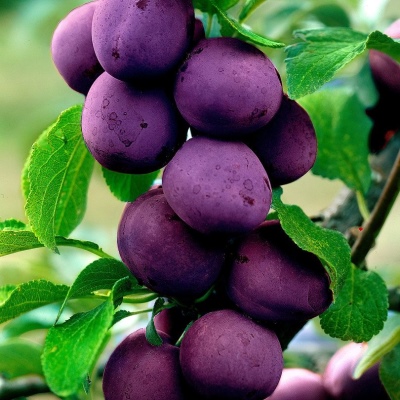
- Name synonyms: Blue Sweet
- Crown: narrow pyramidal
- Tree height, m: 2
- Fruit size: large
- Fruit weight, g: up to 70
- Fruit shape: oval, slightly flattened
- Fruit color: lilac-pinkish
- Pulp (consistency): juicy, rather dense
- Pulp color : yellow-pink
- Bone size: small
The Blue Sweet variety is an unpretentious columnar variety. The plant is characterized by high frost resistance, excellent immunity and excellent fruiting. The fruits are consumed fresh, for making compotes, jams, jam, for freezing and drying. Plum is grown in home gardens and used for industrial cultivation.
Breeding history
This is a very young variety, bred by Hungarian breeders during the cross-pollination of local selection species: Dachny and Bliznets.
Description of the variety
A columnar plum reaches a height of 2 m, a straight and strong trunk, a narrow pyramidal crown with a volume of up to 90 cm. Flowering begins in late April - early May. Ovaries appear on spears and ringlets. The roots are not very developed and are located on the surface. Fruiting up to 18-20 years, then ceases.
Fruit characteristics
Plums are large, weighing up to 70 g, oval, slightly elongated, pink-violet or dark purple in color, with a waxy bloom and subcutaneous dots. The skin is firm, not prone to cracking. The pulp is very dense and juicy, yellowish-pink in color, the stone is small.
The fruits have a good presentation, in a state of removable maturity they are well transported, they can be stored at a temperature of + 6 ... 8 degrees for about a month.
Taste qualities
The taste is refreshing sweet with perceptible sourness, sugar - 11-14%, acids 2-3.5%. According to reviews, they are considered the most delicious.
Ripening and fruiting
The tree begins to bear fruit one year after planting. It is considered a mid-season species in terms of ripening. The fruits begin to ripen in the first half of August, they are not prone to shedding.

Yield
About 13 kg are removed from one young tree, an adult with high-quality agricultural technology can bring 2 times more.
Growing regions
The crop is recommended for growing in temperate climates, primarily in the central part of Russia.
Self-fertility and the need for pollinators
For the appearance of ovaries, a pollinator variety is required to be placed next to it; varieties are suitable: Stanley, Bluefri, Imperial.
Growing and caring
The variety is undemanding to care for. Plum prefers fertile soil saturated with humus. The best time to disembark is in spring, after the snow has melted. Plants are planted in rows at a distance of 30-50 cm from each other and 120-150 cm between rows.
Saplings are chosen for annuals, these take root better. The seedling pit is made 2 times the root volume. A mixture of earth, humus and sand is poured into the hole. The seedling is placed so that the grafting site is above the ground. After planting, watered abundantly by adding a few drops of "Epin" or "Zircon" to warm water.
Young trees must be protected from hypothermia, when the plum gets stronger, it can even withstand Siberian frosts.
Young plums need regular watering and feeding.Nutrients are applied 3 times a year: 1st time after bud break, 2nd - after 2 weeks, 3rd time - 2 more weeks later. For feeding, a urea solution is used: 50 g of the substance are diluted in 10 liters of water, or urea: 50 g of the substance are diluted in 10 liters of water. Pour 2 liters of solution under a tree. At the end of the season, they are fed with phosphorus-potassium compounds. The foliar method is treated with the drug "Heteroauxin".
Mature trees are less demanding for watering: it is enough to moisten them 1-2 times a month, in the absence of rain more often. Some gardeners organize automatic watering.
The first two years after planting, it is recommended to pick off all inflorescences so that the plant grows stronger and forms powerful roots.
The trunk of the tree can be tied to a support - this will reduce the risk of breaking from gusts of wind, especially during the fruiting period. The columnar form does not require formative pruning, but the top sometimes begins to bifurcate - it is better to remove additional shoots. Sanitary pruning is done in early spring or fall. In dry October, water-charging irrigation is done.




Disease and pest resistance
The culture is little susceptible to fungal diseases. For prevention, it is recommended to carry out treatment with a solution of copper sulfate or Bordeaux mixture: in the spring - before the buds appear and at the end of summer - after the harvest.

Despite the fact that plum is considered more hardy than many fruit trees, it is not immune from diseases. It is attacked by viral, fungal and bacterial infections, and parasitic insects harm it. It is necessary to notice and recognize the signs of plum disease in time. They are easier to deal with and defeat early on. Well, in order to protect the garden tree from such a misfortune in the future, preventive procedures can be carried out.
Resistance to soil and climatic conditions
The variety is very winter-hardy: it can withstand temperatures up to -35 degrees, but the top of the plum can freeze under severe frosts. Before the onset of cold weather, the trunk circle is mulched, the tree trunk is carefully covered. For regions with harsh winters, it is better to choose seedlings on a frost-resistant rootstock. The species tolerates drought well, but with a lack of moisture, the yield decreases.

Review overview
Gardeners call the Blue Sweet the northern prune, and appreciate the plant for its small size and bountiful harvest.The taste of plums is characterized as "delicious": slightly unripe fruits with a slight sourness, and when fully ripe, they are very sweet with a vanilla flavor.


































































